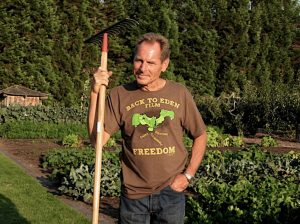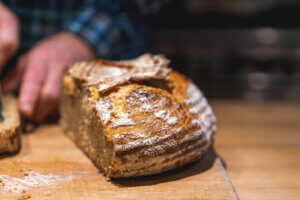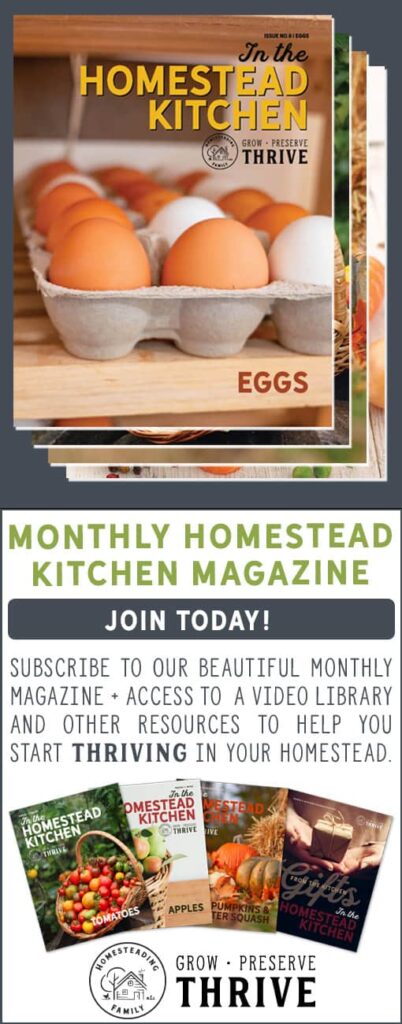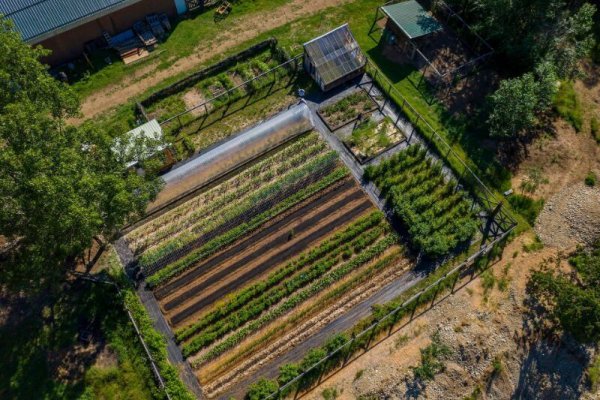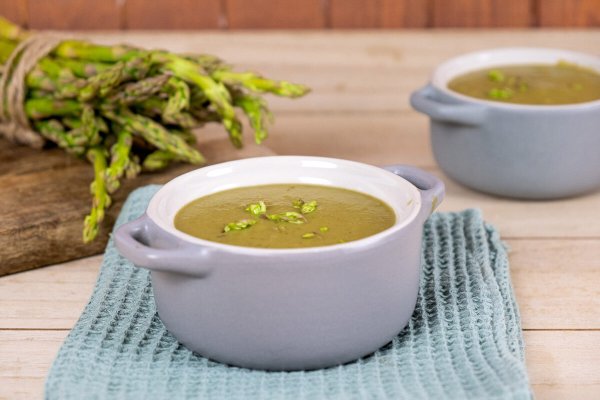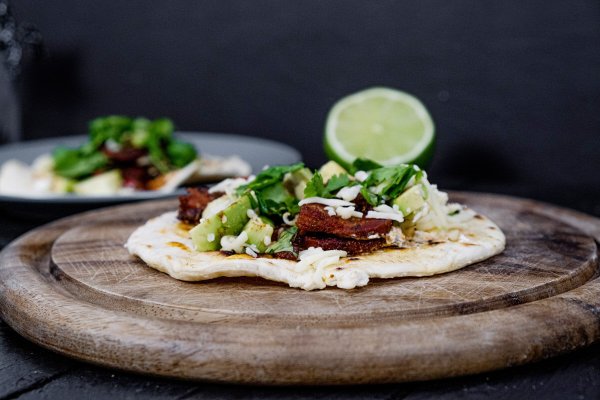

Learn everything you need to know about how to use fermentation for long-term food preservation. When properly fermented, food can last from one to two years safely sitting on your pantry shelf! I’ll teach you how.
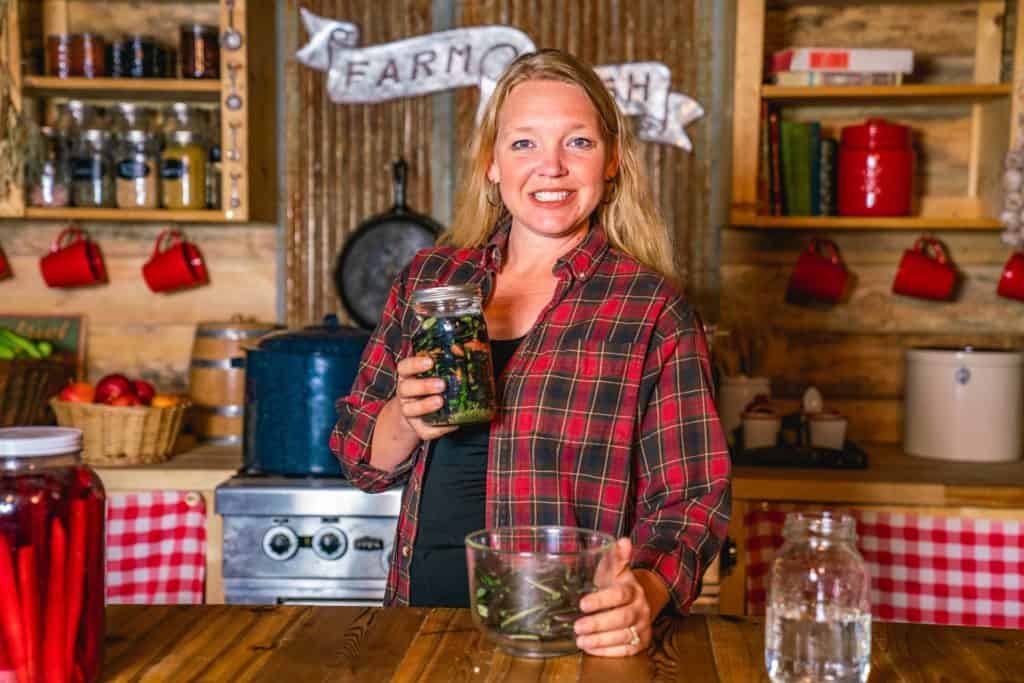
Be sure to check out this post on the basics of fermentation if you haven’t already learned that first. You can also check out these posts on the best fermentation vessels and the best foods to ferment.
In this blog post (and video) I’m going to be diving further into using fermentation for long-term preservation.
What do I mean by long-term preservation? I’m talking from one to two years of a ferment sitting on your pantry shelf and still being good to eat!
Why I Love Fermenting
My favorite thing about fermentation is that it’s one of the fastest ways to preserve food without having to prep a lot of food, jars, or other preservation supplies. It also means I don’t have to heat up my kitchen or spend a lot of time processing. There’s zero wait time when it comes to fermented foods.
See just how simple it is to ferment tomatoes here. We’ve been loving our easy fermented limes all year long. Some of our other favorites are fermented green beans, fermented ginger carrots (those are our kid’s favorite ferment), and, of course, homemade sauerkraut.
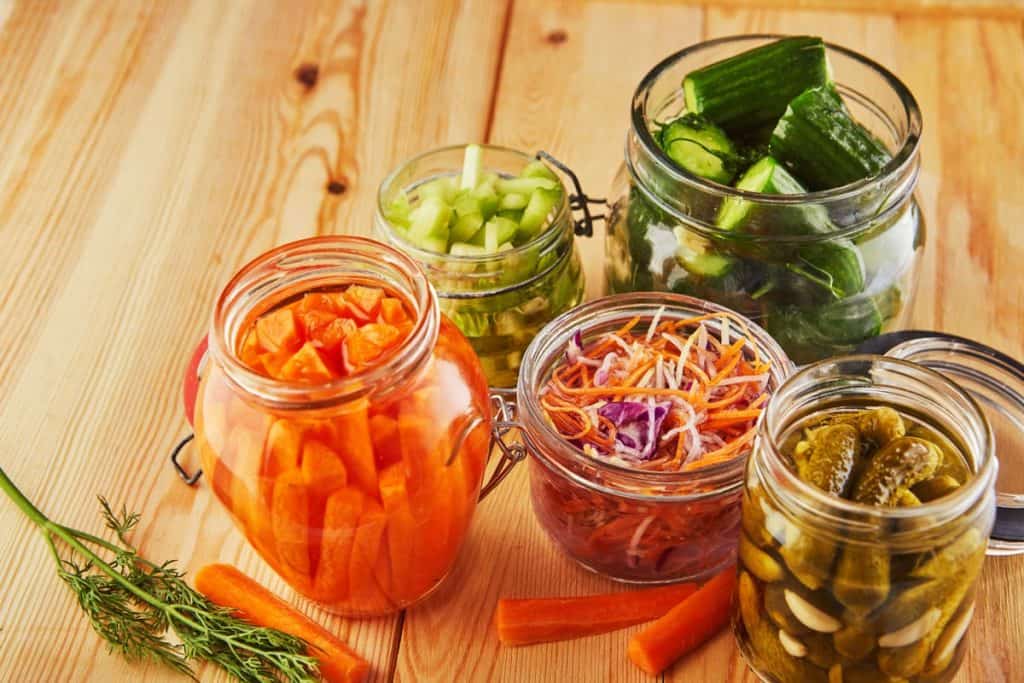
6 Steps to Fermentation
As I mentioned before, if you’re not familiar with each of these steps of the fermentation process, be sure to go check out this Fermenting 101 post first. I’m just going to give a brief overview of the basic fermentation process, then tell you how we adjust it for long-term preservation.
- Get your vegetables ready. When preparing your vegetables it’s best to keep the pieces approximately the same size, whether that’s shredded, cubed, cut into matchsticks or fat sticks, or even left whole.
- Put vegetables into a jar. The next step is to pack your vegetables into your fermentation vessel. This is where you can really pack them in there. The more tightly they’re packed in, the easier it will be for you to keep those vegetables covered with the brine.
- Cover with salt brine. My basic salt brine is pretty salt heavy. In most cases, for long-term preservation, a larger amount of salt is needed. However, if you’ll be utilizing cold storage (such as the refrigerator or cold storage that stays below 50° F, you can typically reduce the amount of salt by half. My basic salt brine ratio is 3 Tablespoons of high-quality fine salt (not a table or iodized salt, we use Redmond Real Salt) for every quart of water. For cold storage, use half the amount.
- Weight the vegetables down under the brine. When it comes to long-term fermentation, you’ll need something that will keep the vegetables under the brine until you’re ready to take that food off the pantry shelf for consumption. Fermentation weights, a large cabbage leaf, or these rounded crocks are great options.
- Allow food to ferment fully. During the fermentation process, you’ll cover the jar loosely to allow air to escape. You’ll likely see bubbles and fermenting liquid that pushes up and out of the container (I like to put my ferments in a casserole dish to catch any spilled liquids). Once the food is fully fermented you will no longer see bubbles or liquid rising to the top of the jar.
- Store food. Once this process is complete, top off the jar with more clean, filtered water and seal the jar up for long-term storage.
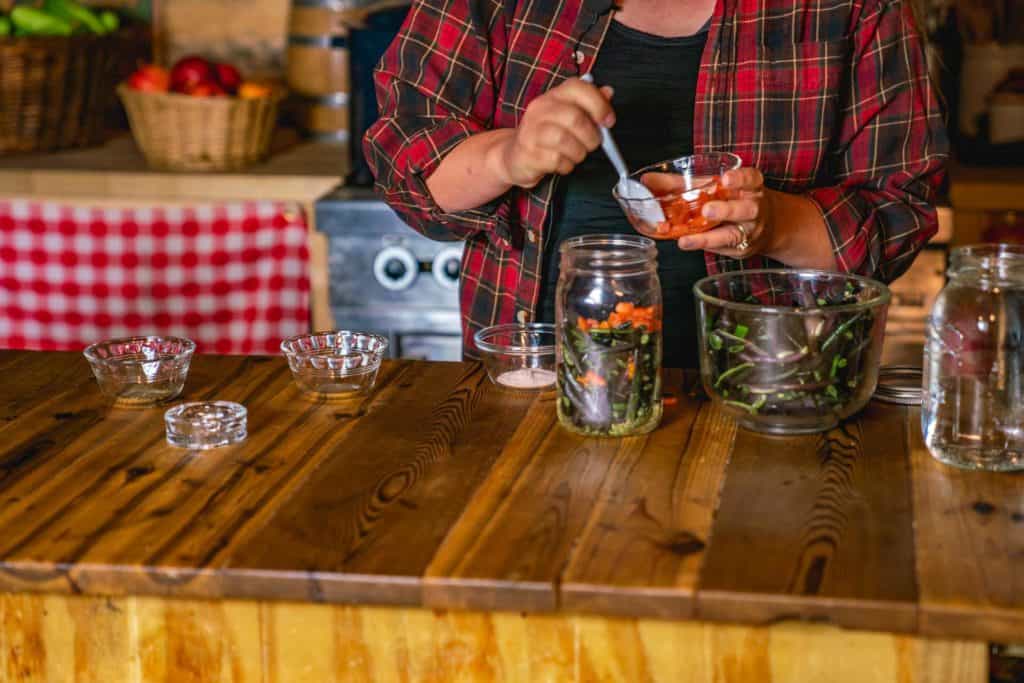
Adapting Ferments for Long-Term Preservation
The real key to keeping ferments good for long-term storage is to sterilize your fermentation vessels and use clean utensils and hands before adding your vegetables.
If you start with a sterilized jar, crock, or container, it won’t matter if the ferment gets tipped after it’s done fermenting because there won’t be any bacteria present on that part of the jar.
When your vegetables are in the vessel initially and fermentation starts kicking off, there are so many good bacteria growing in that jar that they will hunt down any bad bacteria and kill them off.
However, after the fermentation has occurred, it’s extremely important that we don’t dip into those jars with our hands or unsterilized utensils. Anything you introduce into that ferment can actually take over and ruin it.
Fermentation is truly a very simple form of preservation. If you haven’t fermented something I encourage you to just get started (these ginger carrots are a fantastic first ferment). Fermentation is the only preservation method where your food is actually getting healthier while they’re sitting on your pantry shelf!

More Ferments You May Enjoy
- Apple Jalapeño Sauerkraut Recipe
- Homemade Fermented Ginger Carrots
- Lacto-Fermented Sauerkraut
- Fermented Limes
- Preserved Lemons (Fermented Lemons)
- Homemade Kombucha
- “Dr. Pepper” Kombucha
- Curtido Recipe
- How to Make Sourdough Starter
- Lacto-Fermented Green Beans (aka Pizza Beans)
- Fermented Tomatoes (Easiest Tomato Preservation)
- Fermented Cranberry Sauce
- Best Fermenting Vessels (And What Else You Can Use!)
Hey, I'm Carolyn with Homesteading Family, and welcome to this week's edition of the Pantry Chat food for thought. This week, I am all alone. No Josh. He's actually traveling. He is right now in Tennessee doing some work on our super secret special project in conjunction with Anne of All Trades. If you guys don't know her, you should go check her out. She is amazing, absolutely amazing, and does so many wonderful things. But this week we are going to be talking about something that I'm really excited about, and that is fermentation for preservation, not just for eating good food that has been sitting in your refrigerator for a few weeks and making a new fresh ferment every week or two, but actually preserving food for the long-term through preservation. I'm really excited about this. Information on long-term food preservation with fermentation is actually really hard to find, but if you watch the Pantry Chat that I did last week with Stacey from Off Grid with Doug and Stacey, you'll know that she really talked about it.
She really talked about that being one of her number one forms of preservation and the more I learn and the more I experiment with it, the more it's becoming one of my top forms of preservation too, for a couple of reasons. But we're going to dive into that in just a minute. First of all, the chit chat, if you guys are new to the Pantry Chat, we have it all time-stamped for you. So you can jump ahead if you want to bypass the chit chat, but what would a pantry chat be without the chit chat? Now, I got to say it's a little hard chitchatting with myself. And so I really feel the lack of Josh being here today, but I love getting to chit-chat with you guys. So you'll have to do your part and share. If you're watching on YouTube or on a video platform, make sure you share down in the comments what you are doing this week because otherwise, it feels a little like a one-sided conversation.
Okay. But what have I been doing? Well, a lot of you guys know that I have actually been traveling for the last few weeks. I had a lot of fun getting to go over to Melissa K Norris's and film over there. We actually filmed a pantry chat with her. And again, we're working on this super-secret project that we're not sharing publicly yet, but it's going to come out. The information's going to come out. So we really enjoyed getting to be there and hang out with Melissa and having some good friend moments too. And not just, not just filming moments, but you know, some off the camera moments that were really fun too. One of the fun things about getting to hang out with all these different homesteads that I have been able to meet in the last few weeks is the conversation. Because a lot of you guys probably feel this way, that there oftentimes aren't people to have these really good in-depth conversations with when it comes to homesteading things.
And for me, that is definitely the case. It's hard to really get somebody to sit and talk about the ins and outs of fermentation or of soil biology or all of these other homestead topics. And yet I have found myself in more deep conversations with different homesteads over the last few weeks and it's been absolutely glorious. It's been really inspiring and really exciting to hear what other people are working on. And that a lot of people are having kind of the same thoughts that I'm having about how to move forward in things, some of the reoccurring conversations I had centered on making our homestead P more sustainable kind of moving away from the hatchery model, figuring out what else we can do. It's interesting to hear where different people are at on that. Definitely a lot of talk about medicinal herbs right now, and planting herb gardens.
And that's so exciting to me. You guys know, I absolutely love my herb garden and a lot of talk about fermentation out there. And so today I'm going to bring some of those things back to you guys, but that's really what I've been up to. So after Melissa's, Josh and I actually jumped on a plane, flew down to Utah, and went to the Redmond Real Salt homesteading summit event that they held for some of us homestead influencers. I hate to call myself that, that sounds so, I don't know pretentious, I guess, but that's who was there. And it was so much fun getting to hang out with all these other people.
And we learned so much about salt and clay and the health benefits of both. It was really fascinating. Let me tell you, I am never buying the white stuff from the store again because I actually learned what they do to it to make it not clump in your package and to make it very nice and white, they take out a majority of the good stuff in there that your body really needs, and they add all sorts of things in that you don't want. So we've been using Redmond Real Salt for years anyway, just because we find that it's a really healthy good salt. It goes well on our homestead, I can buy it in bulk, but definitely, I think I'm going to stick with using it because everything that I learned was like, oh, that's a good thing we've been doing this. We've saved ourselves a lot of health problems.
So if you haven't looked into them before, I totally recommend that you check them out. I will put the link in the description because they're just a great, great, phenomenal company that is doing wonderful things for our health and for their employees. They're a really cool company. I really appreciated how much they're putting back into their community. So anyways, I spent a lot of time there and a lot of talking time, and now I'm so happy to be back on the homestead, doing my home steady things again, because spring is showing up. We kind of keep having this spring weather where one moment it's hailing and it's sleeting and it's windy, and the next moment it's sunny and warm and beautiful, and the Robins are out and the flowers are starting to bloom. And so it's that time of year where I'm just ready to be here. So yeah, it's exciting stuff.
It's really fun things going on. Okay. Let's jump into the question of the day. Me too on, there are no stupid homestead questions. Do you render your venison fat? If you do, what do you use it for? So you can render venison fat. Absolutely, you can do that, but we don't tend to render it and the reason for it is wild game is generally pretty lean. There have been a few years where the deer have obviously gotten really good food and they're storing up for the winter and they will have a bit of fat on them. But because the venison meat itself is so lean, we tend to put that right back into the grind meat. So whenever we're processing a deer, we're trimming it. We're getting every little bit of meat off of it that we can, and the things that don't end up in nice big roasts or steaks get put in the pile for grinding.
And if you grind it just the way it is, it's so lean that it's not great to eat when it's completely lean like that. So we like to take the fat from the animal. We put that back in. If the animal itself doesn't have a whole lot of fat, we'll often add a little bit of pig back fat, or sometimes B-fat. If we have that in the freezer, whatever we have just in the freezer ready to add that into the mix and into the grind. So that's what we do. With that said, you can absolutely render your venison fat if you get lot on an anima. It is considered tallow and you just do it exactly like large. You do it exactly like B-fat, but you would use it more like a B-fat, which means you don't really want to use it in any instance where your food is going to cool down to a lower room temperature because it'll get grainy. However, it's great in pastry. Something that it's baked into is really good.
So pastries, doughs of any sort like that is a wonderful way to go with your venison fat. Okay. There you have it. Enjoy your venison. The process though is exactly the same as rendering lard, and we have multiple videos out on doing that. Okay. You guys, now I know if you're listening on the podcast, you cannot see this, but I've got to tell you, for those of you guys who don't know, we have a monthly magazine that we are producing. It is that in The Homestead Kitchen Magazine, now it is digital-only, which means you're not going to get this beautiful paper copy if you sign up for it. But I wanted to be able to share it with you guys because we've been doing it for about eight months now and the people who are joining this and are subscribing to this are absolutely loving it. We're getting such great feedback that I really wanted to share it with you guys, but look at how phenomenal this is.
So every month what we do is we take one type of food or produce, and we share all sorts of my recipes and tips for using it. We talk about how to preserve it. We talk about all different methods of preservation and I give my preservation recipes to you guys based on it. We talk about how to cook it fresh, how to bake with it, how to use an instant pot or multi-cooker with it. So we really talk about all sorts of amazing things. We go into a tool focus every month, a homestead tool or kitchen tool that you should really have. And we talk about all sorts of great things in here. So this is available for you to subscribe to. Again, it's just the digital version. It is beautifully designed. It is amazingly written. It is so filled with absolutely great content. And right now you can get the spring greens issue if you subscribe right now. This is issue number eight and it is one of my favorites. I have my mom's a wilted spinach salad recipe in here.
I've got my super greens powder recipe in here. I also have, which goes right into today's discussion, Carolyn's spicy fermented kale stems. This is an amazing way to make great use of a part of a vegetable that you might be throwing away otherwise and turn it into something that is phenomenally good and absolutely delicious. So make sure you check this out. We'll make sure that the link is in the description for you, but get on the subscription list today for this so you don't miss out on one of these issues because they are a lot of fun. They're really great. Okay. So diving into today's topic. Now, I want to say right up front that we have done a whole Pantry Chat on the basics of fermentation. So you can go check out that one. That's where I'm really going to step you through the process and talk about all of the different aspects of basic fermentation.
So we'll put that link for you in the description, but today we're going to dive in a little bit deeper and we're not just talking about the kind of fermenting that has become popular and all over the place, the kind that you make up and then you put it in your fridge and you consume it within the next few months. We're going to talk about actually using fermentation for long-term preservation. I mean a year, I mean a year and a half, two years, sitting on your pantry shelf, that type of preservation. I absolutely love fermentation for preservation because one, it is really low input. I can preserve a ton of vegetables really, really quickly this way without heating up my kitchen, without spending too much time in the kitchen and I don't have to process it in any way. There is no wait time involved.
There's not like turn on the dehydrator and let it run for 12 hours or get your canners going. You might be able to hear my canners running behind me right now. They're cooling down. There is none of that in the fermentation process. And so it's really exciting because it's fast. And if you have a lot of gardens produce coming in this fall that you're expecting, or even this spring or this summer, you'll know that there are the days where you need fast and easy because the produce is piling up faster than you can deal with it. And so this is just a great way to make use of that. Now right of, let's talk about really quickly the basics of fermentation. Like I said, I have that Pantry Chat where I go into this in detail. So I'm just going to walk you through it really quick.
There are six basic steps in fermentation. After we go through those, we're going to talk about how we tweak it a little bit for the long-term preservation. So step number one is to get your vegetables ready and pack them into your fermenting vessel. Now, when we're talking about fermenting vegetables, you have so much latitude as to what vegetables or what mixes of vegetables you want to do. You really can choose. You can pick and choose from just about anything and you can mix it together. The one general rule of thumb is to get all of them cut into about the same size pieces. That's just going to make sure that we ferment it all at the same rate and you don't have these really big chunks and then these little chunks, so you can leave your vegetables whole, you can, especially if you're working with like little cucumbers or small onions or something like that, you can absolutely leave them whole. You can dice them into little squares.
You can make them into match sticks. You can make them into fat sticks, not match sticks. You can go with kindling sticks. How's that? Like something a little bit bigger. Think of carrot stick size. You can shred them in the case of a sour crowd, you have a lot of latitudes when it comes to how to prepare your vegetables, but you really want everything that's going inside that one vessel to be all pretty much the same size, regardless of how you prepare them. So get them packed into a fermenting vessel. Step number two is to cover it with the salt brine. Now my basic salt brine is fairly salt-heavy. I'm actually experimenting a lot right now with how much I can reduce the salt and still be successful. And I found that in most cases for long-term preservation, if I am reducing the temperature. So if I have a cool location to store this for long-term, cool, meaning 55 degrees or less, if I have that, I can generally cut my soul in half and be absolutely fine.
If your only place that you have to store your ferments is somewhere where the temperature really warms up. Let's say you get into the eighties or the nineties during the summer, you really are going to want to go with the full-strength brine. And that amount is three tablespoons of a fine high-quality salt, absolutely not table salt or iodide salt. Those things kill bacteria. And remember, we're trying to grow bacteria in the case of fermentation. Three tablespoons per court of water. Now that is very salty, that is very saline. So just be prepared for that, that is that basic recipe for if you have less than ideal conditions. If you have that cold storage, cut that down to more like one and a half tablespoons per court. Now people hear that and they think, oh my gosh, that's so much hoops. Yes, it is. Yes, your vegetables are going to be salty. However, a lot of that salt is going to stay in the brine. So it's not going to be like you're consuming that entire amount of salt, especially people who are concerned about sodium.
Sometimes that number just really scares them and makes them very concerned. Again, if you're using healthy salt, you shouldn't quite have the water retention problems, but that's a whole different topic. Next, step number three is that you're going to need to weigh those vegetables down in some way that keeps them completely covered by brine long-term. In a short-term fermentation where we're going to stick something into the refrigerator, you just need it to keep under the brine until the main fermentation's done and then you're going to put it in the refrigerator and it really doesn't matter that much at that point. When we're talking long-term fermentation, we need some sort of method that's going to keep our vegetables well under the brine until we go to pull them off our pantry shelf and consume them, excuse me.
So that means that something like a fermenting weight where it's really good for short-term, but you're going to have an awful lot of them if you want to keep a whole bunch of these things on your pantry shelf. So sometimes the best thing to do is actually to use the shape of the fermenting vessel itself to help wedge things down and lock them to place. Again, you can always use the cabbage leaf to cover it, especially if you have shredded vegetables that want to float and get out of the way, use that cabbage leaf or any large strong edible leaf that you can coat over the top and push them down. And then wedge them in there so that they're not floating up to that food line or to the waterline because you don't want them popping out the top. That's when something like mold happens. Okay, once you have it weighted down, then you're going to leave it out in your regular room temperature kitchen counter until it's fully fermented.
When it starts fermenting, you're going to start seeing bubbles. You're going to start seeing things happen. It's often very common for liquid to come out of the jar and actually land on your counter. So I usually put my ferments that are inactive fermentation into a casserole pan to save myself the mopping up. But you're going to see that start to happen. When you're done fully fermenting, it's going to stop. There won't be more bubbles or at many, they'll slow way down. You won't have your liquid coming up anymore. Instead, it will drop way down. So at that point, you have something that's fully fermented. When you see that top off the liquid, it can be just with plain water, remember non chlorinated, anything like that, top hop that off so that it is well covered and make sure you check your weights, make sure it's really weighted down and get that lid blocked completely into place and get it into colder storage.
The coldest storage you have. And if the coldest storage you have is right in a kitchen cabinet and again, it's going to get up to warm summer kitchen temperatures, then that's what you have. And as long as you've used that extra salt you should be fine. So then you're going to put it into your storage, locked down tight with the lid. After that, you can just let it sit there until you're ready to eat it. I have now eaten foods that are one and a half years old just sitting on the pantry shelf, not in the refrigerator. My pantry shelf definitely does not save 55 degrees or lower. Usually, I'm getting up into the mid-sixties by summertime because it is down in my basement, but it can sit there for an incredibly long period of time if you don't open it. Okay.
That is the basics of fermentation. Now let's talk about how we're going to tweak that for long-term preservation. And I want to paint a little picture for you for just a second. Imagine you have a full basket of cucumbers that you bring in and you want to turn them into pickles. Now, traditionally you'd have to heat your pickle brine. You would have to get your canner out, pack your pickles in, pour the hot brine over, and then go ahead and can your pickles. If you're interested in doing that, we have great videos on how two can pickles that stay nice and crispy, but instead of doing any of those steps, instead, you're going to bring those cucumbers in, rinse them off, cut off their blossoms and stuff them straight into a jar with the spices that you want in them. Maybe you're going to stuff them into tin jars that are sitting on your counter.
Now you're going to pour over water and then put the salt directly over the top right into the jar, put a lid on, and shake them up until that salt is fully dissolved. Open up that jar and make sure everything is weighed down and then set them back on the counter. That's the act of work. That is how we ferment something. It is that easy. After a few days of fermenting and that act of ferment, we're going to lock the jars down and stick them on the pantry shelf. And so it's just so much easier than something that involves canning or even dehydrating and this is why it's so wonderful. It's also so wonderful because it's one of the only preservation methods where your food is getting healthier while it's in storage. Those fermentation bacteria actually are creating new vitamins in there. They're creating enzymes, they're doing all these things that are going to actually help you digest and help you be healthier. Okay?
So now what do we do to change this from every direction that you find anywhere on the internet, that's going to help you do a refrigerator ferment and instead turn it into a long-term pantry ferment? The real key that I have found to this is sterilizing your fermenting vessel before you pack your food into it. Now, a lot of people get a little confused by this because here I'm telling you to sterilize it, but then it really doesn't matter if you pack those in with your hands, you don't need to put gloves on and your vegetables are not sterilized when they go in there by any means, we don't want them to be. And so they feel like that's a little inconsistent, but let me explain how this process works. When your vegetables are in the vessel initially and fermentation becomes active, it starts kicking off. There are so many bacteria growing in there. Those are the lactobacillus bacteria and they're the good guys.
They will literally hunt down any other bacteria, any other spoilage agent that could get into your ferment and they're going to kill it. And yes, they do hunt it down and they do kill it. They actually attack the other bacteria and wipe them out. And so that is the process by which they're actually preserving the food. But in that, if you have any bacteria that's gotten in there on your hands, as long as your hands are generally clean, we don't want to put anything dirty in there, gross in there, that could make your ferment go bad. But as long as you're working with clean hands in a generally clean kitchen with generally clean vegetables, you are absolutely good enough because anything that gets into there is going to be killed off by the lactobacillus bacteria.
Now, after that active ferment happens, it's really important that we don't add anything else in there. We don't want to open up that lid. We don't want to put our bare hands into that because that bacteria content and that activity has died down. We're no longer actively fermenting anymore. Which means anything you introduce into that vessel can then take over your ferment and ruin it. So as long as you keep that lid locked down and it safely on your shelf, you're fine. The problem comes in if somebody takes that locked down lid of your ferment, and maybe they shake it a little bit, and let's say your ferment touches a part of the vessel that was not being touched during active fermentation, the bacteria did not have a chance to clean that area. And so if there's anything on there that could be a spoilage agent after that activity and after that active fermenting period, it has a chance to take over your ferment and ruin it and spoil it.
So after that active fermentation period, that's really the moment where we need that sterilized container. If you start with a sterilized container, you start with a sterilized lid, then you'll know that if your ferment gets shaken up or tipped a little or whatever happens to it, it is fine because anything it touches is already sterilized anyways. So that's just fine. That's the reason you can still pack your food with your bare hands. You don't need a sterile environment, which we're really not going to attain in our own home kitchens anyways, in order to be able to ferment long-term. So you guys, now you can take any fermentation recipe that's out there as in vegetable ferment, follow the ingredient, follow the recipes, and make sure that you start with a sterilized container. And you know that you can lock that lid down and stick it on your pantry shelf and it will sit there and last there for you until you're ready to eat it.
Is that a year later? Is that a year and a half later? Now I will say the flavor does continue to develop. And at some point, it might go from absolutely delightful and delicious to too sour or too fermenty. So you do have to pay attention to the flavors that you like, but try it out, see what you can get it away with. See how you like long-term fermentation. I know you're going to like it when it comes to packing it into the jar, because it's so easy, but see how you like pulling it off your shelf and adding it to your salads, eating it as a side dish, topping rice with it. There's so many great ways to enjoy your vegetable ferments. If you feel like you need a step-by-step walkthrough on the fermentation process, check out the video that I did of fermenting carrots. It's one of our favorite ferments in our house. And you guys, don't forget to grab your copy, your digital copy, and subscription to in The Homestead Kitchen Magazine. I can't wait to see you guys next week. Take care. Goodbye.
Sign up to receive email updates
Enter your name and email address below and I'll send you periodic updates about the podcast.



